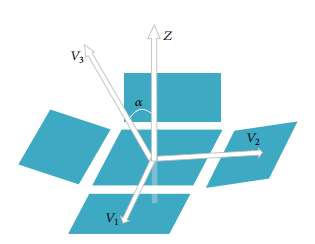1. Introduction
Transparent conductive oxide (TCO) front electrodes are extensively utilised in thin-film silicon (Si) solar cells. Compared to wafer-based Si solar cells, thin-film Si solar cells have a very thin absorber layer (about 200–300 nm for amorphous Si cells and about 1–3 𝜇m for microcrystalline Si cells [1]), which is insufficient for absorbing a large fraction of the incoming solar photons. Therefore the front TCO layer requires a rough surface to scatter incident light into the absorber layer. An efficient light management scheme leads to an elongation of the optical path length in the device and thus a higher chance of photon absorption [1, 2]. As a result, the short-circuit current density (𝐽SC) and the conversion efficiency of the solar cells can be increased.
Therefore, a two-step texturing procedure based on etching in HCl and HF is tested in this study. The idea behind the two-step process is to improve the lateral uniformity of the surface texture and also to further enhance the light scattering via HF etching. In order to achieve a homogeneously textured surface with enhanced light scattering capabilities, in this work we systemically investigate (i) single-step HCl or HF etching as the reference, (ii) two-step etching procedure using HF and then HCl acid, and (iii) two-step etching procedure using HCl and then HF acid for the surface texturisation of AZO films. For these experiments, pulsed DC sputtered AZO films with high transmission (𝑇vis > 85%) in the visible wavelength range and low resistivity (∼8 × 10−4 Ωcm) are used.
2. Experimental Details
2.1. Deposition of AZO Samples. AZO films were deposited onto planar A3 size (30 cm × 40 cm) soda-lime glass sheets by an inline multichamber magnetron sputter machine (Model Line 540 from FHR Anlagenbau GmbH) using a pulsed DC power supply [18]. Dual cylindrical ZnO : Al2O3 (98 : 2 wt%) rotatable ceramic targets were used to deposit the AZO films. The applied power for each cathode was kept constant at 2 kW. During deposition, the substrate heater temperature was kept constant at 350∘ C (the corresponding substrate temperature was maintained at about 190∘ C). The chamber pressure was maintained at 3 × 10−3 mbar by introducing pure argon and oxygen-diluted argon (1% O2 and 99% Ar) as processing gases via mass flow controllers (MFCs) at constant flow rates of 155 and 50 sccm, respectively.
The deposition was carried out in dynamic mode (i.e., moving substrate). During deposition, the glass sheet was vertically attached (i.e., portrait format) on a moving carrier and allowed to oscillate 18 times in front of the AZO sputter cathodes, at a moving speed of 10 mm/s. This multiple-pass deposition potentially reduces the formation of pinholes and thus benefits the subsequent etching process [19]. The rotating speed of the targets was kept constant at 10 rpm for all depositions. After deposition, the AZO-coated glass sheets were cut into 12 square pieces (each 10 cm × 10 cm) for the wet-chemical surface texturing experiments.
2.2. Characterisation. The optical properties of AZO films were characterised with a double-beam UV/Vis/NIR spectrophotometer featuring a 150 mm diameter integrating sphere (PerkinElmer, LAMBDA 950), which records the reflectance and transmittance spectra (diffuse and total) from 300 to 1200 nm before and after texturing the AZO films. The diffuse transmittance was measured by opening the reflectance port at the rear of the integrating sphere and thereby letting the specular light escape from the integrating sphere. The haze value was calculated via
Haze (%) = 𝑇diff 𝑇total × 100, (1)
where Haze, 𝑇diff, and 𝑇total are the transmission haze, the diffuse transmittance, and the total transmittance, respectively. In addition to the spectrophotometer measurements, visible transmission and haze values (in the 350–700 nm range) of the textured AZO films were also recorded with a haze meter (BYK-Gardner, haze-gard plus) to quantitatively evaluate the optical performance. The electrical performance of the AZO films was represented by the sheet resistance value, which was measured with the four-point probe method (Napson, CRESBOX).

Fig1
The AZO film thicknesses were obtained by curve fitting of the measured spectral transmittances, using the commercial optical simulation software CODE [20]. Three dielectric models were used to model the optical properties of the AZO films: the O’Leary-Johnson-Lim (OJL) model, the extended Drude (EDR) model, and Kim’s oscillator model. Details about the fitting method can be found in [20, 21]. The surface morphology resulting from texturing the AZO films was analysed by scanning electron microscopy (SEM; Carl Zeiss, Auriga-39-35) and atomic force microscopy (AFM; Veeco, NanoScope D3100). The AFM images were taken in the central region of each sample, using the tapping mode at a scan rate of 0.5 Hz. The image scan size was set as 10 𝜇m × 10 𝜇m for all samples.
上一篇: 湿化学法控制ZnO纳米结构的研究
下一篇: 简单湿化学法制备ZnO纳米结构